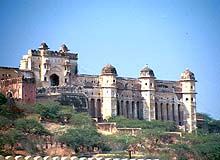 The Amber fort is set in a picturesque location a little away from Jaipur, the capital of Rajasthan state. The Amber Fort presents a fascinating blend of Hindu and Muslim architecture. Raja Man Singh built the Amber fort in the sixteenth century (the construction of the Amber Fort was started in 1592). The Amber Fort is built in red sandstone and white marble. The palace complex of the Amber fort has very attractive apartments. This complex was built by Raja Man Singh, Mirza Raja Jai Singh and Sawai Jai Singh, over a period of about two centuries.
The Amber fort is set in a picturesque location a little away from Jaipur, the capital of Rajasthan state. The Amber Fort presents a fascinating blend of Hindu and Muslim architecture. Raja Man Singh built the Amber fort in the sixteenth century (the construction of the Amber Fort was started in 1592). The Amber Fort is built in red sandstone and white marble. The palace complex of the Amber fort has very attractive apartments. This complex was built by Raja Man Singh, Mirza Raja Jai Singh and Sawai Jai Singh, over a period of about two centuries. The front courtyard of the fort complex is adorned with the splendid, pillared hall of the Diwan-i-Am, and the two-tiered painted gateway, Ganesh Pol. The palace of mirrors (the Sheesh Mahal) is also of special
interest. The Sheesh Mahal has walls inlaid with exquisite mirrors. The Jas Mandir, hanging on the upper floor, is a superb blend of Mughal and Rajput style of architecture, as is evident from the elegantly carved Jali screens and fine mirror and stucco work.
The entrance of the Amber fort is through the 'Dil-e-Aaram' Garden, which is laid out in the traditional Mughal style. An impressive flight of stairs leads to the 'Diwan-e-Am' (hall of public audience) which has latticed galleries and double row of columns each having a capital in the shape of elephants on the top. To the right are steps that lead to the small Kali Temple. The Kali temple has massive doors made of silver.
The walls of Amber fort are adorned with paintings of hunting and war along with precious stones and mirrors set into the plaster. The Maota Lake in the forefront of Amber fort gives spectacular and beautiful reflections of the magnificent Amber Fort-Palace. The most fascinating way to reach the Amber fort is on elephant back. This is truly a royal experience.
No comments:
Post a Comment